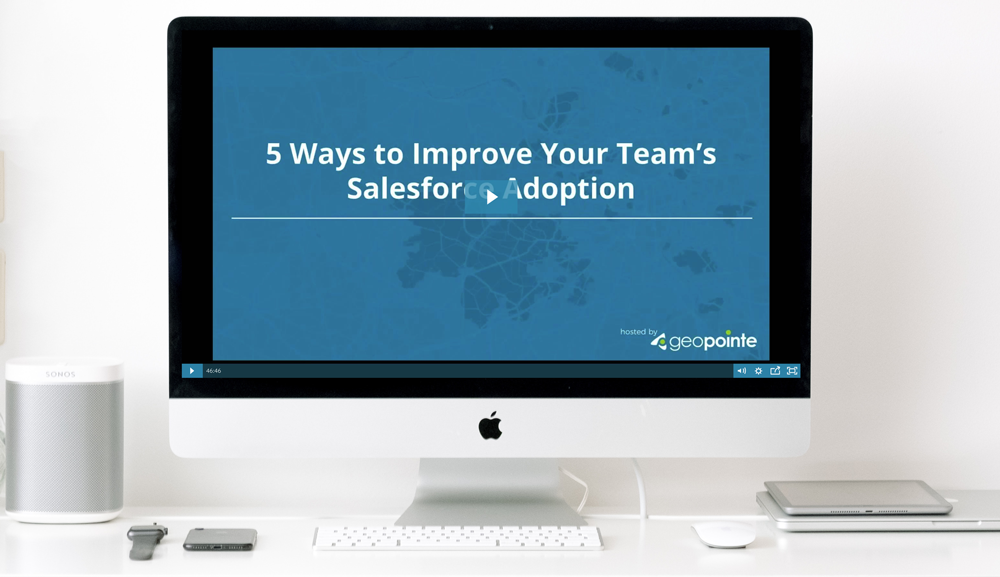
Tips, Tricks & Takeaways from Geopointe’s Recent Webinar
Salesforce is a game-changing business tool that offers countless business benefits. But, before you can reap those benefits, you need to make it through the adoption stage, which can easily go awry without proper guidance. Fortunately, the Geopointe team has seen the many struggles and successes that occur during Salesforce adoptions, and shared that acquired knowledge in our recent 5 Ways to Improve Salesforce Adoption webinar!
Here’s a quick breakdown of each topic the webinar covered, as well as the starting time for each section to help you skim through the webinar recording:
1. Simplify Your Team’s Routine
Starting Time: 7:30
Key Takeaways:
• Replace old obsolete processes
• Rollout in small phases
• Use picklists instead of free text
If you want to keep your Salesforce rollout streamlined, you need to simplify the entire process. Since that’s easier said than done though, Geopointe Technical Support Manager & Certified Salesforce Admin, Ashley Crosby, provided further context from her years of experience.
“Try to do a phased rollout instead. Start simple, and then as your team works through the simpler processes figure out which processes they still need. Maybe some of the processes you had in your other system aren’t needed anymore,” she said. She also had some specific ideas to share, saying, ”Anything you can add a picklist to [in place of a free text] your team is going to be a lot more likely to fill out things and click through things.”
2. Train & Provide Easy to Access Help
Starting Time: 11:40
Key Takeaways:
• Put on company-wide workshops
• Show the new day-in-the-life
• Consider an interactive training tool (e.g. WalkMe)
No matter where you are in your rollout – whether you’re five years in or still in the first month – implementing a training program can streamline the process. In addition to training, Ashley emphasized the importance of providing your team with context. “Make sure that you’re showing them their day-in-the-life. If you’re just showing them how to do a process, but you’re not showing them where this process would be used in their day-to-day work life they’re going to struggle with it more,” she said.
Another way to give further context is to provide them with hands-on training via workshops, or whatever training vehicle makes the most sense for your team and company, according to Ashley. “There are some training processes that aren’t going to work. Maybe that’s across your whole company, or one specific team,” she said.
3. Name Your Champions
Starting Time: 18:40
Key Takeaways:
• Choose influential personalities
• Pick at least one end-user and one executive champion
• Enable and incentivize your champions
Once you’ve fine-tuned your rollout, it’s time to consider an internal PR plan to generate positive internal awareness. The best way to do that is to identify your Salesforce Champions, the people that will broadcast the beauties of your new innovative solution. “These are the people that really embrace change. They’re going to be excited by it. It doesn’t scare them. Even if it does scare them, they can see why it’s valuable and important,” said Ashley on the ideal traits of Salesforce champions.
They should also be influential, according to Ashley. “This doesn’t mean that they’re a C-level executive. This can be somebody who is well respected in their team or has the ability to get their team excited,” said Ashley. That said, seniority never hurts, and you typically want at least one high-ranking leader on board with the process.
4. Gamify the Salesforce Adoption Process
Starting Time: 22:40
Key Takeaways:
• Define goals, metrics and timelines
• Consider prize incentives
• Use a 3rd party gamification app (e.g., LevelEleven)
Beyond your Salesforce Champions, another way to boost morale and generate excitement around your rollout is with gamification. Beyond being a hot buzzword, gamification helps make even the most mundane processes fun and engaging. “It’s partially a big buzzword because it seems to work. People like friendly competition. They like it when these kinds of tasks have a fun element to them,” said Ashley.
However, in order for this gamification process to have strategic value there are a few key factors to consider. “Define goals, metrics, the timeline to complete these things and consider prizes. You also need a way to actually report on this, have these goals and metrics ber visible to your team and make it easy for them to follow along,” she said.
5. Integrate the Tools Your Team Needs & Uses
Starting Time: 26:50
Key Takeaways:
• Use native Salesforce apps
• Search in the Salesforce AppExchange
• Explore All-in-the-Stack
It’s challenging to get a team to fully adopt Salesforce when they have to leave the platform to log in to a dozen other applications on a daily basis in order to get their job done. The solution? Integrate native third-party Salesforce apps into the process. This allows you to interact with your data in new ways, without ever leaving your Salesforce Org. “It also allows you to tailor your Salesforce org to meet your specific needs, and make it a custom fit for you,” said Ashley.
To find the best apps for your needs you’ll want to explore the Salesforce AppExchange. “It will give you a sense of what [apps] could be useful and meet your needs, and [the apps] are all filterable, so if you don’t have the money to pay for things right away, you can just turn those off and just look at the free ones,” she said. She also recommended Geopointe, LevelEleven, Cirrus Insights and Conga as a few go-to apps with a proven track record of success.
Want to watch the full webinar recording? Click the button below!



